
Navigate your pedestrian accident claims confidently with a trusted Fort Worth lawyer. Get the compensation you deserve for your injuries and losses today!

Navigate your pedestrian accident claims confidently with a trusted Fort Worth lawyer. Get the compensation you deserve for your injuries and losses today!
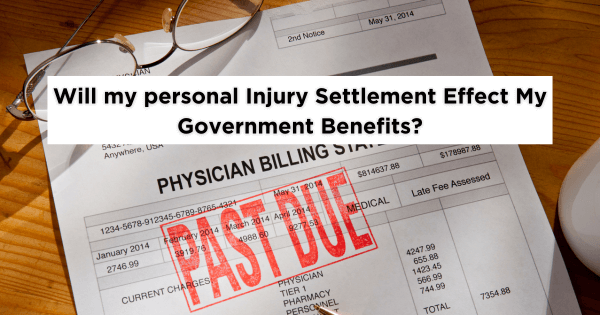
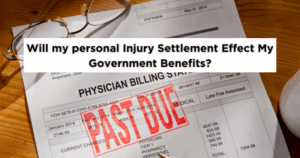
A personal injury settlement can impact eligibility for SSI, Medicaid, and other essential government benefits.
A personal injury settlement can unexpectedly push your financial resources above eligibility thresholds, potentially terminating critical government benefits. In this article, you’ll discover how a settlement interacts with means-tested programs—SSI and Medicaid—alongside entitlement benefits like SSDI and Medicare. You’ll learn about Medicare Set-Asides (MSAs), special needs trusts, structured settlements, spend-down tactics, ABLE accounts, and state-specific rules in Texas. Finally, we map out a proactive timeline and how an expert team can help safeguard your benefits after an accident payout.
Supplemental Security Income (SSI) is a federal needs-based benefit for disabled, blind, or elderly individuals with limited income and resources. A personal injury settlement often counts as income in the month received and as a resource thereafter, which means a large lump sum can immediately disqualify you from SSI. Structured planning or trust arrangements can keep settlement funds off your balance sheet and preserve your monthly SSI payments.
Below is a summary of the core limits that determine SSI eligibility and how settlement funds may exceed these thresholds.
Meeting these limits is essential because any amount above $2,000 in countable resources or unexcluded income can trigger SSI suspension or termination.
A lump sum settlement is counted as unearned income in the first month, reducing benefits dollar for dollar, then becomes a countable resource in subsequent months. This mechanism means:
Understanding these rules highlights the importance of careful financial structuring immediately after receiving funds.
Structured settlements divide your award into periodic payments rather than one lump sum. They:
Opting for a structured settlement aligns payment amounts with SSI thresholds, maintaining your eligibility for ongoing benefits.
Structured settlements, which provide scheduled payouts over many years rather than a single lump sum, saw a significant increase in use in 2023, with premiums jumping to $8.6 billion. These arrangements offer plaintiffs long-term financial security, tax-free payments, and the ability to design customized payment schedules, making them a valuable tool for managing personal injury awards.
Several legal and financial tools can shield settlement funds from SSI resource tests:
Implementing one or more of these tactics ensures settlement proceeds support your needs without jeopardizing SSI.
A Special Needs Trust (SNT) is a legal tool that allows individuals with disabilities to hold assets, such as personal injury settlement proceeds, without jeopardizing their eligibility for means-tested government benefits like Medicaid and Supplemental Security Income (SSI). These trusts are crucial for long-term financial security, especially given the high costs of care, and must adhere to strict regulations regarding disbursements to supplement, not supplant, government programs.
Medicaid provides health coverage for low-income individuals and families. Like SSI, Medicaid is subject to strict income and asset tests. A settlement may trigger a state lien or push your countable resources above permissible limits, resulting in benefit loss or repayment obligations.
Different Medicaid categories have varying thresholds. The table below outlines typical limits for an adult beneficiary.
Any settlement amount above these limits must be managed or sheltered to maintain Medicaid eligibility.
State Medicaid agencies have subrogation rights to recover medical costs paid on your behalf. This process involves:
Proactive negotiation can minimize the repayment amount and preserve more of your settlement.
A first-party Special Needs Trust (SNT) holds settlement proceeds for disability-related expenses without counting as a Medicaid asset. Types include:
By funneling settlement funds into an SNT, you maintain Medicaid eligibility and ensure beneficiary-specific care.
Medicaid regulations vary by state.
In Texas:
Local expertise is essential to navigate these nuances and negotiate favorable outcomes.
A Medicare Set-Aside (MSA) is a portion of your settlement reserved for future Medicare-covered medical expenses related to your injury. MSAs ensure Medicare’s interests are protected, complying with the Medicare Secondary Payer Act.
An MSA is required when:
Meeting these conditions avoids Medicare recovery actions after your settlement.
Medicare Set-Asides (MSAs) remain a critical consideration in liability settlements, ensuring Medicare’s future interests are protected in cases where future medical treatment related to an injury is anticipated. While there is no statutory or regulatory mandate for MSAs in liability settlements, plaintiffs’ attorneys must assess the need for an MSA to protect future Medicare coverage for claim-related expenses and educate clients on proper administration.
An MSA funds anticipated injury-related care, preventing you from depleting Medicare while still preserving benefits. By allocating settlement dollars to an MSA:
This arrangement secures your long-term medical coverage.
You can fund and manage an MSA in two primary ways:
Medicare’s recovery rights include liens on your settlement to reimburse conditional payments. Lien implications:
Understanding lien mechanics ensures you retain as much of your award as possible.
Social Security Disability Insurance (SSDI) is an earned benefit based on work history, not need. As such, SSDI remains intact regardless of your personal injury settlement. SSDI eligibility and payment amounts are governed by the Social Security Administration’s wage credits and not by income or assets.
SSDI is funded through payroll taxes and tied to your insured status. Since SSDI does not consider resource or income limits, a settlement does not alter your entitlement. This distinction underscores why SSDI beneficiaries can receive awards without losing monthly benefits.
Even though SSDI checks continue:
These steps preserve SSDI payments and avoid inadvertent overpayments.
Implementing the right combination of tools can safeguard settlement funds and maintain benefit eligibility across programs.
Special Needs Trusts isolate settlement funds for disability-related expenses without counting them as income or assets. Key features include:
Leveraging SNTs is widely recognized as the primary protection strategy for means-tested benefits.
Spend-down involves converting countable resources into exempt assets before reaching resource caps. Common tactics:
Timely execution of spend-down strategies aligns your resource profile with eligibility rules.
ABLE accounts permit tax-advantaged savings for qualified disability expenses, offering:
ABLE accounts complement SNTs and structured settlements for holistic protection.
Structured settlements and lump sums differ across five critical dimensions:
Rules for liens, eligibility, and recovery vary by jurisdiction. In Texas, specific statutes and agency practices influence outcomes.
Under Texas Human Resources Code §32.033, the state can claim against your settlement for medical costs paid. Key points:
Navigating these statutes is critical to minimize Texas Medicaid’s reimbursement demands.
Texas follows federal SSI limits and applies the same asset tests for Medicaid:
Staying within these parameters preserves both SSI and Medicaid benefits in Texas.
State-specific rules and administrative procedures differ substantially. An attorney with Texas practice experience can:
Local counsel ensures your plan aligns with Texas requirements and maximizes benefit preservation.
Early planning is the cornerstone of benefit protection. Addressing eligibility rules before settlement disbursement avoids costly mistakes and ensures a seamless transition.
Planning before settlement receipt prevents unintended disqualification:
Proactive measures eliminate last-minute scrambling and protect your ongoing benefits.
A multidisciplinary team ensures comprehensive planning:
Coordinated expertise aligns all strategies for maximal benefit preservation.
Implement this timeline for seamless benefit protection:
Following this roadmap secures your benefits and optimizes settlement utilization.
Injured individuals facing the complexities of government benefits need clear, actionable planning from day one. By understanding SSI, Medicaid, Medicare, and SSDI rules—and leveraging trusts, structured settlements, and ABLE accounts—you preserve essential support while maximizing your settlement’s value. Engage experienced legal and financial professionals early to craft a tailored strategy that aligns with federal and Texas-specific regulations. With proactive guidance and precise execution, you can protect your government benefits and focus on recovery without financial fear.
A personal injury settlement should help you move forward — not put your Medicaid, SSI, or Medicare coverage at risk. At Howard, Lotspeich, Alexander & Williams, PLLC (HLAW), we understand the need to structure settlements and coordinate with benefit programs to protect your long-term care and financial security.
Schedule a free, no-obligation case evaluation today. Call us at 817-993-9249 or fill out our online contact form to speak directly with an experienced Texas personal injury attorney. Let us help you maximize your recovery while safeguarding the government benefits you rely on.
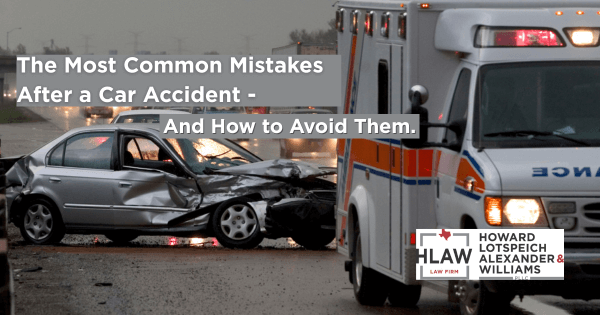
Every year, thousands of accident victims in Texas compromise their personal injury claims and recovery by overlooking critical steps the moment a collision occurs. Missing essential actions—from calling the police to documenting your injuries—can weaken evidence, reduce compensation, and expose you to legal pitfalls unique to Texas law. In this guide, you will learn how to avoid six categories of post-accident errors:
By understanding these common missteps and following clear, actionable advice, you can protect your rights, maximize your settlement, and accelerate your physical and financial recovery in Texas.
Navigating the aftermath of a car accident in Texas can be overwhelming. Howard Lotspeich Alexander & Williams, PLLC (HLAW) stands apart with a proven track record of success, deep understanding of Texas personal injury law, and a commitment to our clients’ well-being. We offer:
Schedule Your Free Consultation
Failing to take the correct first actions after a crash in Texas undermines your personal injury claim and can expose you to legal consequences. Immediate missteps often involve law enforcement, witness information, and communication errors that insurers and attorneys scrutinize. Learning what not to do sets the stage for stronger evidence and a smoother claims process.
In Texas, calling law enforcement is crucial, especially if the accident involves injury, death, or property damage exceeding $1,000. An official Texas Peace Officer’s Crash Report (CR-3) documents location, damage, and statements from all parties. This report serves as independent evidence that verifies your account and supports your insurance claim and potential lawsuit. Without this official report, insurers may question liability or argue conflicting versions of events, making your claim much harder to prove in Texas.
Police reports are a foundational tool in any car accident case, offering an unbiased snapshot of the crash by a trained observer. They help confirm the accident, prove liability, corroborate medical records, and demonstrate negligence, thereby lending credibility and weight to the claimant’s version of events.
This research highlights how an official police report serves as independent evidence, verifying the account of the accident and supporting insurance claims and potential lawsuits, which directly aligns with the article’s advice to always call the police.
Attorney Tip: “A police report isn’t just a formality; it’s often the first piece of objective evidence in your case. Without it, you’re relying solely on conflicting testimonies, which can significantly complicate proving liability,” advises HLAW partner, Jesse Lotspeich.
In Texas, leaving the scene of an accident before officials arrive, especially if there’s injury, death, or significant property damage, constitutes a ‘hit and run’ offense. This can lead to severe criminal charges, including fines, jail time, and license suspension, as well as the loss of uninsured motorist benefits. Fleeing the scene can also invalidate your own insurance claim. Staying until Texas law enforcement completes their report is essential to safeguard your legal and financial interests.
Case Example: In a recent Texas case, a driver who left the scene of a minor fender-bender later faced felony charges when the other party reported a delayed injury. The initial property damage was under $1,000, but the act of fleeing escalated the legal consequences dramatically, illustrating the severe risks of not waiting for law enforcement.
Neglecting to collect the other driver’s name, contact, insurance policy, and vehicle details hampers claim processing and reconstruction of events. Without complete information, your insurer may deny coverage or delay benefits while chasing down elusive data. Always record full driver, witness, and plate details on the police report and your own notes.
Expert Insight: “Thorough documentation at the scene, including contact information for all parties and witnesses, is non-negotiable. It’s the bedrock of your claim and prevents insurers from claiming a lack of verifiable data,” emphasizes HLAW Partner Jason Howard.
Admitting guilt—even saying “I’m sorry”—can be construed as an admission of liability and used against you in settlement negotiations or court. Insurance adjusters leverage any self-incriminating statements to minimize payouts. Instead, stick to factual descriptions of what happened: “My car and the other vehicle collided at the intersection.”
Expert Insight: “Even a seemingly innocent ‘I’m sorry’ can be twisted by insurance adjusters into an admission of fault. Your primary concern should be safety and information exchange, not assigning blame,” states HLAW Partner Luke Williams.
Avoid discussing fault, assuming blame, or speculating on injuries in conversations with other drivers or passengers. Simple remarks like “I shouldn’t have turned” or “I think you hit me” create recordable admissions. Instead, exchange essential information and politely defer fault discussions to your insurance companies and legal counsel.
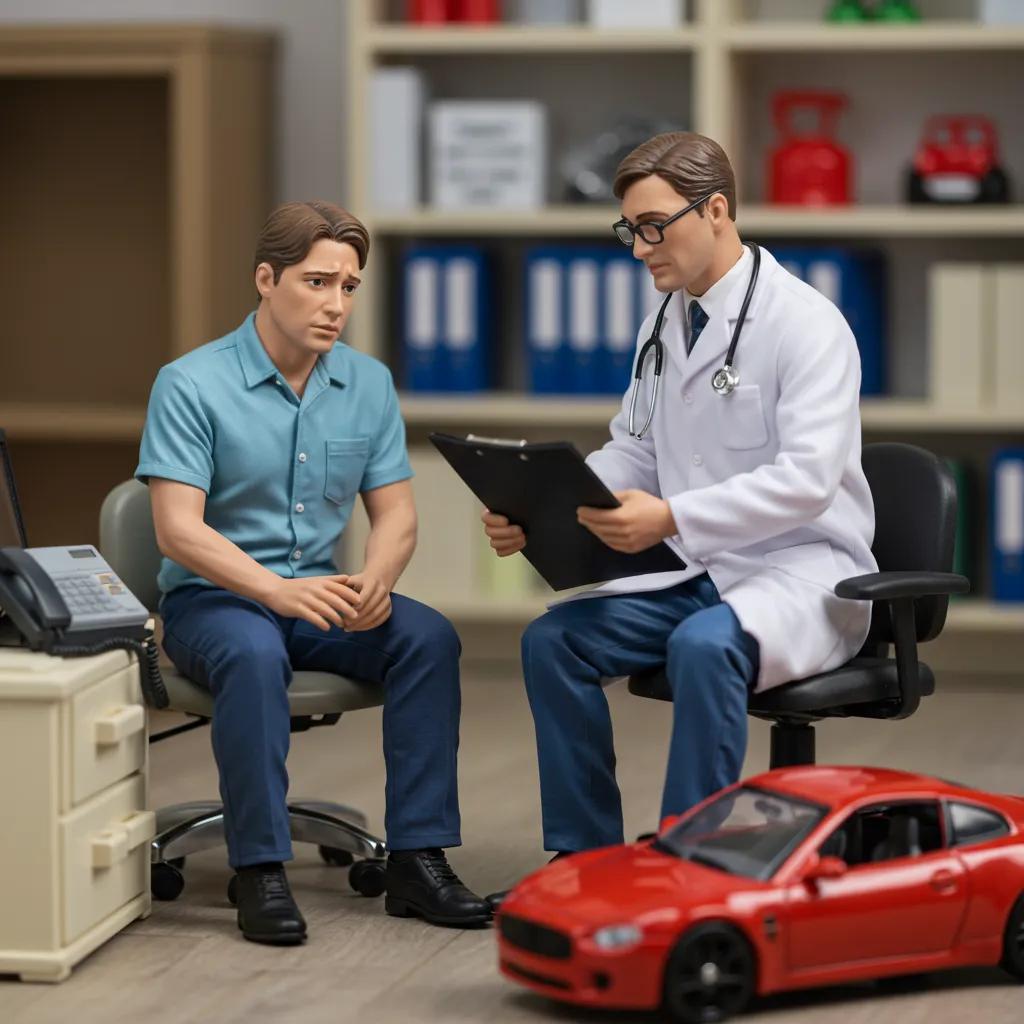
Ignoring or postponing medical care after a collision undermines the link between the crash and your injuries, reducing compensation for pain, suffering, and lost wages. Prompt treatment and thorough documentation verify injuries and strengthen your personal injury claim.
Delaying care allows hidden injuries—such as whiplash, concussions, or internal bleeding—to worsen without clinical documentation. Insurers often argue that untreated conditions stem from pre-existing issues rather than the collision. Seeking immediate evaluation preserves objective evidence of causation and severity.
Attorney Tip: “One of the biggest hurdles we face is when clients delay medical treatment. Insurance companies will seize on this, claiming your injuries aren’t serious or weren’t caused by the accident. Get checked out immediately, even if you feel fine,” advises the HLAW legal team.
Delaying medical care after an accident can have serious consequences for both health and personal injury claims. Insurance companies frequently exploit delayed treatment to undermine the severity of injuries or reduce compensation, often arguing that the injury occurred after the incident or was not directly caused by the accident.
This research underscores the article’s point that ignoring or postponing medical care weakens the crucial link between the crash and injuries, providing insurers with grounds to dispute causation and severity, thereby reducing potential compensation.
Adherence to prescribed therapies, medications, and follow-up visits creates a medical record trail demonstrating your commitment to recovery. Failure to comply can be cited as negligence, prompting insurers to reduce benefits or deny long-term disability claims. Completing all treatment recommendations substantiates your damages.
Incomplete medical records, missing physician notes, or gaps between treatments leave attorneys and adjusters skeptical about injury authenticity. Every doctor’s diagnosis, imaging report, and therapy session note serves as proof of injury and prognosis. Consistent documentation ensures a cohesive narrative linking the accident to your losses.

Insurance carriers use tactics to minimize payouts. Missteps such as providing recorded statements or accepting lowball offers can lock you into inadequate compensation. Recognizing these errors protects your rights and maximizes your settlement.
Recorded statements can be edited or taken out of context to challenge your credibility or shift liability. Adjusters ask leading questions designed to elicit responses that downplay damage. Politely decline to record details without legal representation and provide only high-level facts in writing.
Initial offers are often significantly below actual repair and medical costs. Accepting too soon waives your right to pursue additional damages for ongoing pain or unexpected expenses. Reviewing offers with a personal injury attorney ensures you receive fair market value for property damage, medical bills, and non-economic losses.
Attorney’s Perspective: “Insurance companies are businesses, and their first offer is almost always designed to settle your claim for the least amount possible. It rarely accounts for future medical needs, lost earning capacity, or the full extent of your pain and suffering. Always have an experienced attorney review any settlement offer,” emphasizes Jess Lotspeich.
Promptly report the crash to your insurer—ideally within 24 hours—using only factual information: date, time, location, and parties involved. Delayed notification can trigger policy breaches and claim denials. Provide documented proof such as police reports and photos rather than verbal embellishments.
The other party’s insurer represents the at-fault driver, not your interests. Casual remarks or medical updates can be used to reduce liability or link injuries to other events. Always refer adjusters to your attorney and communicate only through formal channels to safeguard your claim.
Counter these by maintaining organized records, consulting a qualified personal injury lawyer, and refusing to sign releases until fully compensated.
Failure to meet filing deadlines, gather essential evidence, or engage legal counsel can bar your ability to seek compensation. Clear documentation and timely action preserve your right to recover damages.
In Texas, the statute of limitations for most personal injury claims arising from a car accident is two years from the date of the incident. This means you generally have two years to file a lawsuit. However, there are exceptions, such as claims against governmental entities, which often have much shorter notice requirements (sometimes as little as six months). Missing this critical deadline in Texas permanently forfeits your right to seek compensation through the courts.
Photographs of vehicle damage, skid marks, road conditions, and witness statements create a factual record of the incident. Preserved evidence prevents loss or tampering, enabling accident reconstruction experts to verify fault and support your personal injury claim.
Early representation ensures all deadlines are met, documentation is collected properly, and negotiations leverage expert guidance.
Unrecorded expenses—towing fees, rental cars, prescription costs—are often excluded from final settlements. Maintaining an itemized ledger with receipts substantiates your out-of-pocket losses, ensuring you recover every legitimate cost tied to the collision.
Statements of apology can constitute an admission of liability under certain laws, exposing you to comparative negligence claims that reduce your payout proportionally. Always express regret for distress, not fault, and let police reports or your attorney address liability.
Online posts and public comments offer insurers real-time access to your behavior, enabling them to challenge injury claims or suggest exaggeration. Controlling your digital footprint is as critical as gathering on-scene evidence.
Photos or comments suggesting you’re healthy or active—ostensibly innocent—can be used to dispute injury severity. Insurance adjusters routinely monitor public profiles for contradictions. Refrain from sharing any details or images related to your crash, treatment, or legal process.
Insurance adjusters routinely scrutinize social media accounts for evidence that can undermine injury claims. Even seemingly harmless posts, photos, or check-ins can be taken out of context and used to argue that injuries are not as severe as claimed or to challenge the claimant’s credibility in court.
This research directly supports the article’s warning that online posts and public comments can be accessed and used by insurers to challenge injury claims or suggest exaggeration, emphasizing the critical importance of controlling one’s digital footprint during a claim.
Casual conversations about fault or injuries with friends, family, or online forums create multiple informal records that insurers can access. Even deleted messages or private chats may be subpoenaed. Keep all discussions about your claim confined to your attorney and medical professionals.
Failing to secure profiles or inadvertently approving friend requests from adjusters compromises confidentiality. Enable strict privacy controls, deactivate location tagging, and avoid posting physical activities that could contradict your medical records.
Texas imposes unique reporting rules, deadlines, and damage caps. Ignoring these variations can derail your claim or leave you undercompensated.
In Texas, you are legally required to report a car accident to the Texas Department of Transportation (TxDOT) if it results in injury, death, or property damage to an apparent extent of at least $1,000. This report, known as the Texas Peace Officer’s Crash Report (CR-3), must typically be filed by law enforcement within 10 days of the incident. If law enforcement does not investigate, you may need to file a Driver’s Crash Report (Form CR-2) yourself. Failing to meet these reporting requirements can lead to fines and negatively impact your insurance claim.
Texas operates under a modified comparative negligence rule, often referred to as ‘proportionate responsibility.’ This means that if you are found to be 51% or more at fault for the accident, you are barred from recovering any damages. If you are found to be 50% or less at fault, your compensation will be reduced by your percentage of fault. For example, if you are 20% at fault for an accident with $10,000 in damages, you can only recover $8,000. Understanding Texas’s proportionate responsibility laws is crucial for accurate expectations and legal strategy.
“They are very impressive, bright, organized, faithful and compassionate people. It will be worth your time to give them a call. If they can help, you will be in strong hands. And even if they can’t help, they’ll steer you correctly. Give them a call when the legal walls are closing in. I have no hesitation referring good people in a bad spot to the attorneys here.”
— HLAW Client, Fort Worth, TX
This guide was compiled by our team of dedicated and experienced legal professionals specializing in Texas personal injury law. With decades of combined experience, our attorneys have successfully represented countless accident victims across the state, securing fair compensation and justice. Our commitment extends beyond the courtroom; we are passionate about empowering individuals with accurate, actionable information to protect their rights and secure fair compensation. We pride ourselves on our deep understanding of Texas statutes, our aggressive advocacy for our clients, and our compassionate approach to every case.
The information provided in this guide is for general informational purposes only and does not constitute legal advice. It is not a substitute for professional legal counsel. Laws are complex and subject to change, and individual circumstances vary significantly. While we strive for accuracy, this content may not reflect the most current legal developments. Always consult with a qualified Texas personal injury attorney for advice tailored to your specific situation and to ensure compliance with all applicable laws and deadlines. Relying solely on this information without professional legal guidance could have adverse consequences for your claim.
Following a consistent, step-by-step approach after every collision prevents oversights and enhances your claim’s strength. Integrate these strategies to protect your rights, evidence, and recovery trajectory.
Taking systematic photos of vehicle damage, road signage, skid marks, and your visible injuries establishes credible evidence. Numbered logs and time-stamped images prevent gaps. Back up all digital files and share them with your attorney for secure preservation.
Engage an attorney when liability is contested, injuries are severe, or you encounter unfair settlement tactics. A seasoned lawyer coordinates evidence gathering, medical evaluations, and pressure-tested negotiations to secure optimal compensation.
Structured, professional interactions maintain your leverage and prevent inadvertent concessions.
Avoid immediate mistakes by involving police, exchanging data, and steering clear of self-incriminating remarks. Treat injuries promptly and follow medical advice meticulously. Recognize insurance tactics and engage a lawyer before negotiating. Comply with all Texas-specific rules and document every expense. Proactive, organized action transforms a stressful crash into a defensible, well-substantiated claim that can yield fair compensation and peace of mind.
Get Your Free Case Review Today
If you’ve been involved in a car accident in Texas, protect your rights and maximize your recovery. Our experienced personal injury attorneys are here to provide a free, no-obligation consultation to discuss your case and guide you through the complexities of Texas law.
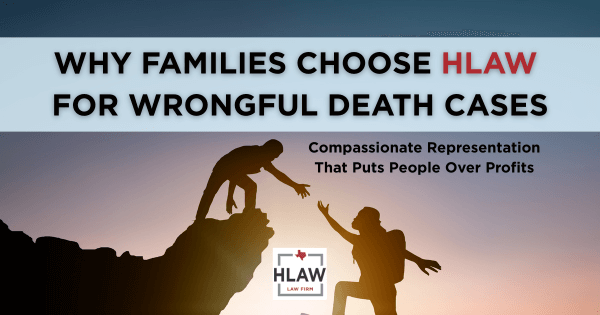
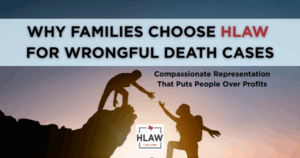
HLAW stands beside grieving families, offering personalized legal representation and genuine care after a wrongful death tragedy.
When someone you love is taken from you because of another’s negligence, your world changes forever. The grief is overwhelming, and the legal system feels cold and impersonal—especially if your only exposure to wrongful death representation comes from loud television ads and billboards.
At Howard Lotspeich Alexander & Williams, PLLC (HLAW) we believe families deserve something different.
We’re not a mega-firm chasing numbers; we’re a team of local attorneys committed to walking with you through one of life’s most devastating moments, while relentlessly pursuing justice for your loved one.
“We’re not just lawyers—we’re neighbors who care about what happens to the people who make North Texas home.” -Luke Williams, Partner, HLAW
We live here. We raise our children here. We support our schools, churches, and small businesses here. That local connection means we treat every client as a neighbor, not a transaction.
Our understanding of North Texas—its roads, workplaces, courts, and juries—gives us insight that large “television commercial” firms can’t match.
But more importantly, we understand the people. When you sit down with us, you’ll meet the lawyers who genuinely care about your story and your loss. And, those are the lawyers who you’ll directly deal with (we never pass your case off to an associate or junior attorney).
“We don’t view wrongful death cases as paperwork to be processed — we see them as profound trusts placed in our hands” – Jess Lotspeich, Partner, HLAW
That perspective shapes every step we take:
“Every wrongful death case is about more than statutes and damages—it’s about people, memories, and futures.” – Jason Howard, Partner, HLAW
We see ourselves as both advocates and allies. We’re here to:
Large advertising firms may promise fast and aggressive results, but speed isn’t the same as care. Our commitment is to provide thoughtful, individualized service—never cookie-cutter solutions. We limit the number of wrongful death cases we accept so that every family gets the attention and preparation they deserve.
“When you trust us with your loved one’s story, we treat that responsibility with the care it deserves.” -Laura Alexander, Partner, HLAW
Whether your case involves a car crash, an industrial accident, a commercial truck, a dangerous product, or another preventable tragedy, we have the experience (20+ years handling wrongful death claims) to take on powerful defendants and insurance companies. And because we work on a contingency fee, you don’t pay unless we win for you.
Unfortunately, these days, other law firms have resorted to high-pressure and predatory tactics to get you to retain them to represent you in wrongful death cases. HLAW refuses to air gimmicky commercials or employ solicitors who hound you. We maintain that as we adhere to our principals, our ethics and a genuine drive to help families out with care and compassion, those that need us will find us. We stand at the ready to represent you and your family and be a light during one of the darkest moments you may have ever been through.
If you’ve lost someone because of another’s negligence, we invite you to talk with us—without pressure or obligation.
Call us today at (817) 993-9249 or contact us online to schedule a free consultation and case evaluation.
Together, we can honor your loved one’s memory, seek accountability and compensation, and help your family move toward peace.


Howard Lotspeich Alexander & Williams explains how Texas victims of sexual assault in massage settings can hold therapists and spas accountable through civil claims.
When you book a massage, you’re placing tremendous trust in a licensed professional. If that trust is violated through any form of sexual contact or exploitation, you’re not only dealing with trauma—you’re suddenly navigating medical, legal, and financial decisions you never asked for. This guide explains what Texas law says, who may be held civilly liable, deadlines that apply, and how a civil case works, so you can make informed choices about healing and accountability.
Texas strictly bans sexual contact in massage establishments. State rules make it unlawful for an establishment to allow any person—including a therapist or client—to engage in sexual contact on the premises, and they bar nudity and other sexualized conditions during services. These rules sit on top of the criminal laws against sexual assault.
Massage therapists in Texas are licensed under Occupations Code Chapter 455, and the Texas Department of Licensing & Regulation (TDLR) enforces these rules and can sanction or shut down violators. You can also file an administrative complaint with TDLR (this is separate from a civil lawsuit).
Under the Texas Penal Code §22.011, sexual assault includes penetration or certain sexual contact without consent, and the law recognizes power-imbalance scenarios (e.g., certain health or mental-health provider dynamics) as “without consent.” While a massage therapist is not automatically treated as a “health care services provider,” many cases still qualify as sexual assault because consent is absent, coerced, or otherwise invalid.
Importantly, Texas massage rules also require specific, written consent before any breast massage of a female client—anything else is outside the rules. Violations of these professional standards can support your civil case.
Depending on the facts, you may have civil claims against:
Texas administrative rules make clear that establishments must prevent sexual contact, nudity, and other red-flag conditions; documentation and compliance lapses at the spa level often become critical evidence.
Texas extends the time to sue for injuries arising from sexual assault:
Bottom line: Do not delay. Evidence disappears and deadlines are unforgiving, even with these extensions.
Depending on your case, you may seek:
Texas caps punitive damages in many cases, but the cap does not apply when the defendant’s conduct constitutes certain intentional felonies—including sexual assault—committed knowingly or intentionally. That exception appears in CPRC §41.008(c). (A criminal conviction isn’t required to pursue the civil exception; the civil jury looks at the conduct and mental state.)
A civil lawsuit is separate from licensing and criminal processes, but they often run in parallel. TDLR can investigate, fine, suspend, or revoke a license, and it has authority to shut down establishments in certain circumstances. Filing a TDLR complaint can help protect others and may uncover records useful to your civil case.
Intake forms, “consents,” or arbitration provisions don’t excuse sexual assault. Some clauses are unenforceable as written, and others have carve-outs. We review every document and challenge unfair provisions where appropriate.
We approach these cases with compassion, confidentiality, and urgency. We handle the legal strategy while coordinating with your care providers and, if you choose, with TDLR and law enforcement. If you or someone you love was assaulted in a massage setting anywhere in Texas, reach out for a confidential consult—we’ll walk you through options and next steps.
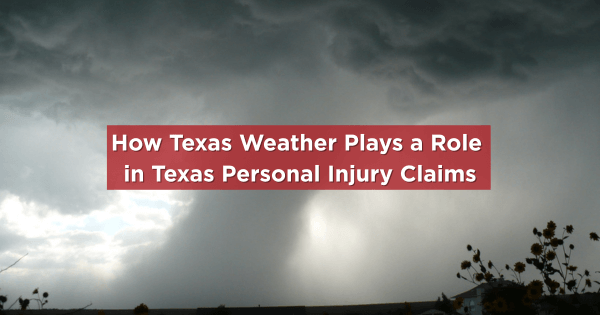
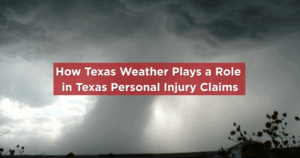
From heavy rain to icy sidewalks, Texas weather can create dangerous conditions that lead to personal injury claims.
Texas weather is anything but predictable. From spring thunderstorms to icy winter mornings and even the occasional hurricane, our state’s climate can create dangerous conditions that lead to serious injuries. When someone is hurt because a property owner failed to address these hazards, a personal injury claim may arise under premises liability law.
In this article, we’ll break down how Texas weather contributes to personal injury claims, the duties of property owners, and what victims need to know if they’re injured due to rain, ice, or storm debris or damage.
Premises liability is a legal theory that holds property owners and occupiers responsible for injuries caused by unsafe conditions on their property. The injured party (known as the “invitee,” “licensee,” or sometimes “trespasser”) must show that the owner:
Weather-related hazards fall squarely under this framework — but proving liability can be tricky, especially when storms or ice are involved.
Rain may seem harmless, but it can quickly create dangerous slip-and-fall conditions. Smooth surfaces like tile, polished concrete, or wood decks become slick when wet.
Tip: Photographs of the scene immediately after a fall can be powerful evidence of negligence.
While ice storms are less frequent in Texas than in northern states, freezing precipitation can paralyze entire cities. Sidewalks, parking lots, and stairs become treacherous during sleet or snow events.
Courts recognize that it’s not always possible to clear ice immediately, but an owner’s response must be reasonable given the circumstances.
Texas is no stranger to high winds, hail, and hurricanes. After a storm, broken tree limbs, fallen signs, or scattered debris can injure visitors.
Weather creates a unique defense for property owners: the “act of God” doctrine. If a hazard is caused by sudden, uncontrollable weather — and the owner had no reasonable opportunity to fix it — they may avoid liability.
Key factors courts consider:
This is why prompt investigation and documentation are essential for injured parties.
If you’re hurt because of rain, ice, or storm debris, you can protect your claim by:
A skilled attorney can:
Texas weather may be unpredictable, but property owners still have a duty to protect visitors from foreseeable hazards like rainwater, icy walkways, and storm debris. If you or someone you love has been injured due to unsafe conditions after bad weather, don’t wait to get help.
Contact our firm today for a free consultation. We’ll evaluate your case, gather evidence, and fight for the compensation you deserve.

Debunking misconceptions in Texas that can hurt injured riders in court or settlement talks
Motorcyclists already fight an uphill battle against bias. Add a handful of persistent myths, and a valid injury claim can be undervalued—or lost entirely. Below, we break down the most common misconceptions we see in Texas cases and set the record straight with practical, courtroom-ready guidance.
Reality: Texas uses modified comparative negligence, not wearing a helmet is not an automatic bar to a lawsuit or claim.
Under the proportionate responsibility statute, your recovery is reduced by your percentage of fault and barred only if you are more than 50% at fault. See Tex. Civ. Prac. & Rem. Code (CPRC) §33.001–.003. Failure to wear a helmet is not negligence per se and does not automatically defeat your claim. It may become a damages issue only if the defense proves a causal link between the lack of a helmet and the injuries you’re claiming.
Texas helmet law, quickly: Riders under 21 must wear a helmet; riders 21+ may ride without one if they’ve completed a safety course or carry the required insurance. See Tex. Transp. Code §661.003. Police generally can’t stop an adult rider solely to check helmet qualifications. In civil cases, defense lawyers sometimes try to analogize the Texas Supreme Court’s seat-belt ruling (allowing non-use evidence when causally relevant) to helmets. The take-home: it’s a fact-specific mitigation argument, not a total bar.
What helps: medical causation testimony tying head/face injuries (or the lack of them) to actual crash dynamics; biomechanical opinions; and focusing the jury on the primary negligence (left-turn, unsafe lane change, failure to yield) rather than equipment debates.
Reality: Lane splitting is not legal in Texas.
Texas requires vehicles—including motorcycles—to remain within a single lane and only move to another lane when it is safe. See Tex. Transp. Code §545.060. A rider who threads between lanes risks a comparative fault finding. That said, the driver’s independent negligence (unsafe left turn, failure to keep a proper lookout, texting, etc.) still stands and may carry the larger share of fault.
What helps: scene photos/video, speed analysis, witness statements on the driver’s actions, and clear testimony about rider conspicuity and escape options.
Reality: In Texas, liability carriers typically pay once—in a lump-sum settlement or judgment.
During treatment, you’ll usually rely on PIP/MedPay, health insurance, or letters of protection obtained with the help of an attorney. Personal Injury Protection (PIP) must be included in Texas auto policies unless rejected in writing; minimum limits are commonly $2,500 (many purchase more). See Tex. Ins. Code §1952.151 et seq. UM/UIM coverage must also be offered and can fill the gap when the at-fault driver is uninsured or underinsured (Tex. Ins. Code §1952.101).
What helps: verify and stack available coverages early (PIP, MedPay, UM/UIM, third-party liability), confirm written rejections, and align medical billing to reduce balance-billing surprises.
Reality: It’s helpful, but not dispositive.
Crash reports often contain hearsay, opinions, and incomplete facts. They’re useful leads, but liability turns on admissible evidence and a jury’s allocation of fault. We corroborate (or challenge) the report with photos, EDR/ECM data, dashcam, smart-home or business cameras, 911 audio, phone metadata, and expert analysis.
What helps: rapid preservation letters, on-scene measurements, and prompt open-records requests. Don’t let the only story in the file be the first one written.
Reality: You don’t owe a recorded statement to the other side.
Cooperate with your insurer as your policy requires, but politely decline recorded interviews from the adverse carrier. Adjusters are trained to lock in admissions and minimize claims. We provide evidence in writing at the right time and with the right context.
What helps: route all communications through your lawyer; provide concise, verified, non-recorded factual updates when tactically advantageous.
Reality: UM can still cover you—often the difference-maker.
Texas Uninsured Motorist coverage is designed for exactly this situation. Promptly report the crash to law enforcement and your insurer, document the attempted identification, and preserve all video (helmet cam, dashcam, nearby businesses). A quick canvass often finds a camera you didn’t know was there.
Reality: It is—but you have to prove it.
Texas permits recovery of non-economic damages (pain, mental anguish, physical impairment, disfigurement, loss of enjoyment) along with economic losses (medical bills, wage loss, diminished earning capacity). There’s no general PI cap outside medical malpractice; exemplary (punitive) damages are available for fraud, malice, or gross negligence, subject to CPRC §41.008 caps.
What helps: consistent treatment records; specific day-in-the-life examples; employer corroboration; before-and-after witnesses; photos of visible injuries; and functional testing.
Reality: Comparative negligence assigns percentages, not absolutes.
Even if a rider shares some blame (e.g., modest speeding), you can still recover so long as your responsibility does not exceed 50% (CPRC §33.001). Defense experts often overstate speed—accident reconstruction, skid analysis, and video frame-rate work can bring the number back to reality.
Reality: The statute of limitations is generally two years from the crash (or death).
See CPRC §16.003. Claims involving governmental entities trigger notice deadlines as short as 6 months (and some cities/charters even shorter) under the Texas Tort Claims Act, §101.101. Negotiations do not toll the statute. File or toll, or risk losing the claim.
Reality: Juror bias is real, but evidence beats stereotypes.
Clear liability narratives, humanized riders (family, work, safety training), expert-driven crash analysis, and smart voir dire go a long way. We show visibility challenges drivers should anticipate (left-turn across path, blind-spot merges), transform “biker bias” into a driver-duty case, and anchor damages to objective proof.
Is lane filtering ever allowed at a red light?
Not under current Texas law. Treat it like any other lane rule (Transp. Code §545.060).
Will not wearing a helmet kill my case?
No. It may become a limited damages issue if causally tied to head injuries, but it’s not an automatic bar (CPRC Ch. 33; Transp. Code §661.003).
Can I use PIP (Personal Injury Protection) if I was on a motorcycle?
PIP is tied to the auto policy terms. Many Texas policies cover the named insured and household family members as pedestrians or occupants of a motor vehicle—check your declarations and endorsements. If it was your auto policy, PIP often still applies; if it was the other driver’s policy, it won’t.
What if a city truck hit me?
You likely face short notice deadlines and damage caps under the Texas Tort Claims Act (CPRC Ch. 101). Act fast.
How long do I have to file?
Generally two years (CPRC §16.003). There are exceptions (minors, government, wrongful death), so get a legal review immediately.
We understand both the bias riders face and the physics of motorcycle crashes. We build cases around driver duty, not stereotypes—backed by reconstruction experts, medical specialists, and a trial-ready file from day one. Whether you ride a cruiser on 377 or commute through West 7th in Fort Worth, Texas, your case deserves a fair look and full value.
If you or someone you love has been injured in a motorcycle accident anywhere in Texas, don’t wait to get the help you deserve. The sooner an experienced attorney is on your side, the stronger your claim will be. At HLAW, we know how to overcome bias against riders, protect crucial evidence, and fight for every dollar you’re owed.
Our team will:
You don’t have to face insurance adjusters, complex laws, or mounting medical bills alone. Contact us today for a free, no-obligation consultation—let us put our experienced team and resources to work for you and your family.
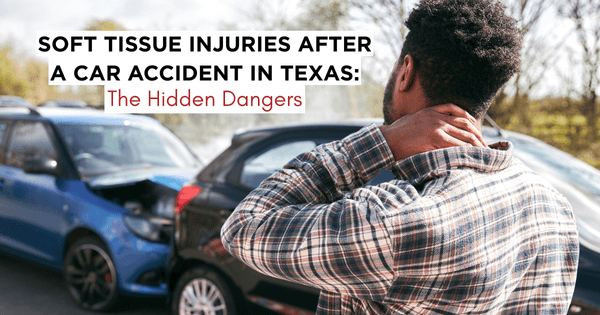
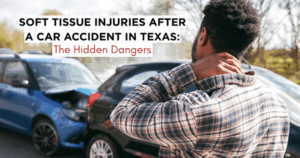
Even minor accidents can leave lasting pain. Learn how whiplash, sprains, and disc injuries can impact your health and your Texas injury claim.
When people picture a “serious” car accident, they often imagine mangled vehicles, shattered glass, or a trip to the emergency room. But in reality, even a collision that leaves only a small dent in your bumper can cause lasting and painful injuries. Among the most overlooked are soft tissue injuries—damage to muscles, ligaments, and discs that don’t show up on an X-ray but can change the course of your daily life.
In Texas, many accident victims find themselves facing months of pain, physical therapy, and financial strain from these hidden injuries. If you’ve been in a wreck, it’s important to understand why soft tissue injuries after a car accident should never be taken lightly.
“Soft tissue” refers to the muscles, ligaments, and tendons that support your body and allow you to move. In a car accident, these tissues can stretch, tear, or become inflamed from the sudden forces involved—even when vehicles are traveling at low speeds.
Common examples include:
The hidden risk of soft tissue injuries is that symptoms don’t always appear right away. Adrenaline and shock can mask pain immediately after a crash. In some cases, it takes days or even weeks before stiffness, soreness, or radiating pain becomes obvious.
By the time symptoms set in, an injured person may have already downplayed the accident to insurance companies—or worse, signed away their rights to fair compensation.
In Texas, we often see insurance adjusters argue that if the car wasn’t badly damaged, the driver couldn’t have been badly hurt. But medical science says otherwise: it’s possible to suffer serious whiplash or disc injuries even in low-impact accidents.
If you’ve been in an accident, watch for:
If you experience delayed symptoms after a wreck, here’s what you should do:
At Howard, Lotspeich, Alexander & Williams, PLLC (HLAW), we know how insurance companies work—and we know how to fight back. We’ve seen firsthand how clients suffer from soft tissue injuries that others tried to minimize. We take the time to understand your pain, gather the medical evidence, and build a case that reflects the true impact of your injuries.
The hidden danger of soft tissue injuries is real: they may not show up right away, but they can cause long-lasting pain and disruption to your life. Don’t let the insurance company dismiss your claim just because your car wasn’t totaled. If you’ve been in a wreck and are experiencing pain, reach out for help today.
Contact us for a free consultation. We’ll review your case, explain your rights, and fight to make sure you get the compensation you deserve.

Dashcams are everywhere now—from commuters on I-35W to rideshare drivers on West 7th in Fort Worth, Texas. When a crash happens, those few seconds of video can be the difference between a strong claim and a tough fight. Below is a practical, Texas-specific guide to using dashcam footage the right way: is it legal to record, how courts admit it, how to preserve it so it actually holds up, and how we present it to insurers and juries.
Recording is generally legal. Texas is a “one-party consent” state for recording conversations. If you are a party to the conversation (or one party consents), audio recording is lawful. Texas Penal Code §16.02 and related guidance confirm one-party consent, and Texas also provides a civil cause of action against illegal interceptions in Chapter 123 of the Civil Practice & Remedies Code.
Mind the windshield. Texas restricts objects or materials on the windshield that obstruct the driver’s view. If your dashcam (or its mount, cord, or stickers) materially obstructs your view, that can be a traffic offense—and in a lawsuit, the defense may argue the placement contributed to the crash. See Transportation Code §547.613 (Restrictions on Windows).
Privacy pitfalls. Audio of passengers is usually fine if you’re in the conversation, but secretly recording other people’s private conversations can trigger criminal and civil liability. (There’s a private civil cause of action for unlawful interception, with statutory damages, under CPRC §123.002.)
Texas courts admit dashcam video under the ordinary Rules of Evidence—no special “tech rules” required. We focus on four pillars: relevance, authentication, best-evidence, and hearsay.
Once a crash happens—and certainly once a claim is reasonably anticipated—you have a duty to preserve relevant evidence. Texas’s spoliation doctrine (from Brookshire Brothers, Ltd. v. Aldridge) allows courts to impose sanctions or adverse inferences if evidence is lost or altered.
Our recommended preservation protocol (do these immediately):
Texas discovery has special rules for electronic data:
Q: My dashcam overwrites footage every few hours. What now?
Pull the power, remove the card, and preserve immediately. If it is overwritten, ask us about subpoenas/preservation letters to nearby businesses, city traffic cams, or the other driver’s telematics/dashcam. Texas spoliation law rewards early, reasonable preservation efforts.
Q: Do I have to give the insurer my video right away?
We usually control the release until we’ve reviewed the liability and damages strategy. If we share early, we provide a faithful and accurate copy and preserve the original per the best-evidence rules.
Q: The clip has my passenger talking. Is that a problem?
Not usually. Texas is one-party consent; if you were a participant, the recording is lawful. If someone else’s private conversation was captured (and you were not a party), talk to us before sharing.
Q: Can the court reject my video because it’s a copy?
Not if it’s an accurate duplicate and authenticity isn’t in reasonable dispute (Rule 1003). If authenticity is challenged, we offer the original or explain why it’s unavailable under Rule 1004.
Dashcam footage can make your Texas car accident case—but only if it’s lawfully recorded, properly preserved, and cleanly authenticated. Our team at the HLAW law firm builds the evidentiary foundation from day one so insurers and juries see what really happened—clearly and credibly.
If you have dashcam video from a crash (or think someone else does), contact our office right away. We’ll lock down the evidence, send preservation letters, and put it to work for your case.
Dashcam footage can be a game-changer—but only if it’s preserved and presented correctly. If you’ve been injured in a car or truck accident, don’t wait. Insurance companies and defense attorneys will act fast to minimize your claim.
📞 Contact HLAW today for a free consultation. Our experienced personal injury attorneys will review your case, secure critical evidence like dashcam video, and fight to get you the compensation you deserve.
Your first call costs nothing—and it could make all the difference in your recovery.
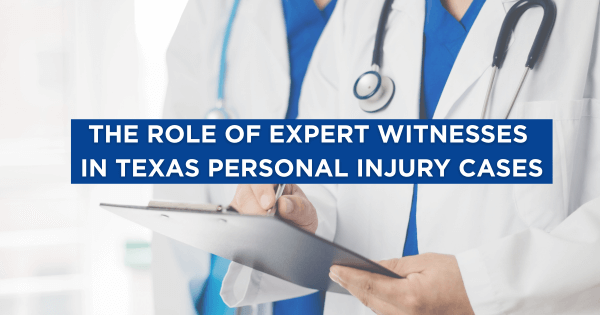

Expert witnesses—such as medical professionals, engineers, and accident reconstructionists—play a critical role in proving Texas personal injury claims.
When you’ve been injured in an accident—whether in a car crash, trucking accident, a workplace incident, or on someone else’s property—your claim often comes down to one question: Can you prove it? In Texas personal injury cases, proving fault and the extent of your damages isn’t just about telling your story—it’s about presenting credible, persuasive evidence. That’s where expert witnesses play a critical role.
Under Texas law, an “expert” is someone who has “scientific, technical, or other specialized knowledge” that will help the judge or jury understand the evidence or determine a fact in issue (see Texas Rules of Evidence, Rule 702). These experts provide opinions grounded in their professional training and experience—opinions that can make or break your case.
Expert witnesses are different from regular witnesses. Regular witnesses can only testify about what they personally saw, heard, or experienced. Experts, on the other hand, can:
The Texas Supreme Court has emphasized that expert testimony must be reliable and relevant—meaning it must be based on sound methodology and actually help the factfinder (see E.I. du Pont de Nemours & Co. v. Robinson, 923 S.W.2d 549 (Tex. 1995)).
In most personal injury claims, medical testimony is key to proving the nature and extent of your injuries. Medical experts can:
In Texas, medical causation often requires expert testimony—especially for complex or non-obvious injuries (Guevara v. Ferrer, 247 S.W.3d 662 (Tex. 2007)).
Engineering experts analyze structures, machinery, and environmental conditions that may have contributed to your accident. They are invaluable in:
Texas premises liability law (see Texas Civil Practice & Remedies Code § 75.002 and § 101.022) often hinges on whether a property owner knew of and failed to correct a dangerous condition—an engineering expert can help prove this.
Accident reconstructionists use physics, engineering principles, and crash data to recreate the events leading up to an accident. They can:
These experts are particularly useful in auto and trucking accident cases governed by Texas Transportation Code and federal motor carrier safety regulations.
In Texas, juries decide most personal injury cases. A well-qualified expert can help:
An expert’s ability to explain “why” something happened—and back it up with evidence—can dramatically strengthen your position at mediation, in settlement negotiations, or at trial.
Texas courts apply a strict standard for admitting expert testimony. Rule 702 requires that:
Courts also apply the factors to evaluate reliability, which include:
If your attorney doesn’t choose the right expert or prepare them properly, your evidence could be excluded—leaving you without the proof you need.
At Howard, Lotspeich, Alexander & Williams, PLLC (HLAW), we know which experts can make the difference in your case. We regularly work with respected medical professionals, engineers, and accident reconstructionists across Texas who have the experience and credibility to stand up in court.
Here’s why consulting with us—at no cost to you—is the smartest move:
Whether you’ve been in a serious car crash, trucking accident, suffered an injury on the job, or been hurt by a defective product, having the right expert testimony can be the deciding factor. Don’t take chances with your case.
Free Consultation:
If you or a loved one has been injured, contact HLAW today for a free, no-obligation case review. We’ll explain whether expert witnesses could help in your situation—and how we can put them to work for you. Call us at 817-993-9249 or fill out our online form to get started.